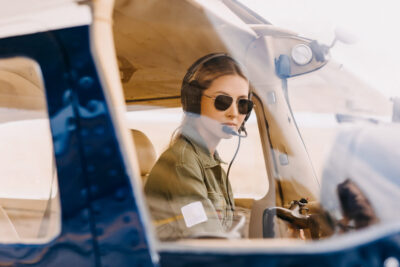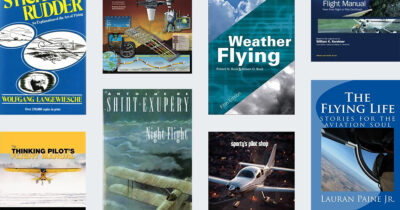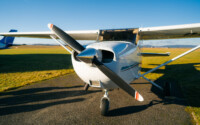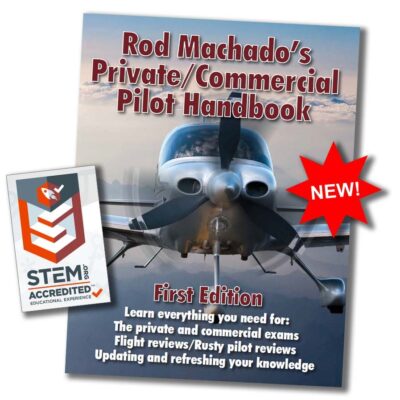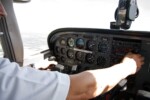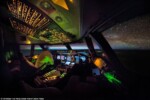10 Must-Read Books for Student Pilots
6 July 2021 | Updated on February 05, 2024
Becoming a pilot is not just about logging hours in the sky or acing written exams. It’s about building a robust foundation of knowledge and understanding that can guide you when you’re thousands of feet above the ground. While flight simulators, interactive software, and online courses can certainly play a vital role in your aviation education, there’s still something remarkably powerful about picking up a physical book.
But we know there’s a sea of aviation books out there, and finding the ones that will truly benefit your pilot training can be overwhelming. That’s where we come in. We’ve sifted through countless titles to bring you a curated list of ten standout books that provide invaluable insight and knowledge. From fundamental principles to advanced concepts, these books cover a wide array of topics that every student pilot needs to master.
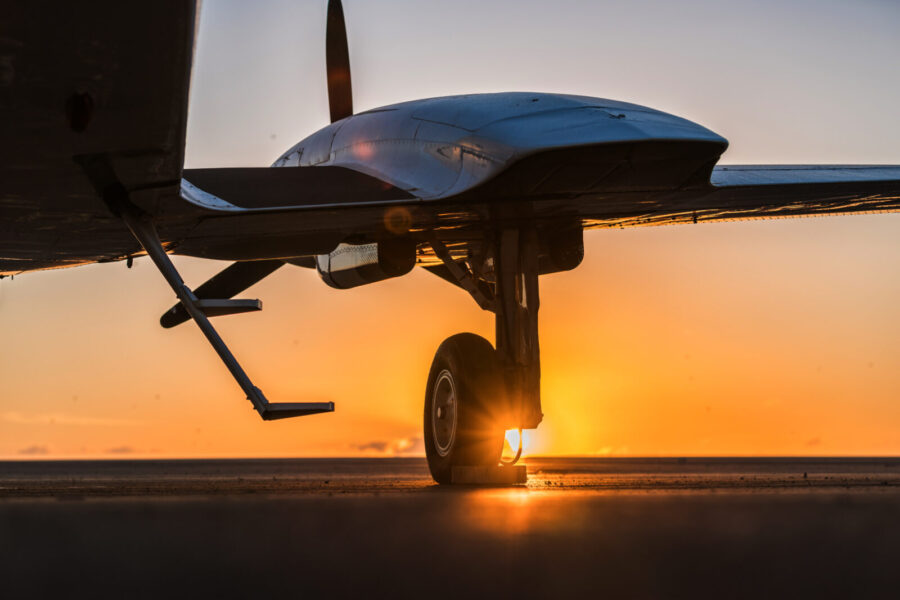

10 Must-Read Books for Student Pilots
1. Stick and Rudder: An Explanation of the Art of Flying, by Wolfgang Langewiesche
First on our list is a timeless classic, “Stick and Rudder” by Wolfgang Langewiesche. Originally published in 1944, this book remains one of the most influential and widely read texts on the art of flying.
As the title suggests, “Stick and Rudder” is all about the fundamentals of flying. Langewiesche simplifies the concepts of aviation, breaking down the mystery of flight into understandable elements. The book delves into the principles of aeronautics, including lift, drag, and thrust, and presents them in a way that is both informative and enjoyable to read.
It is the first exact analysis of the art of flying ever attempted and has been continuously in print for thirty-three years.
Why is this book so beneficial for student pilots? Well, the unique value of “Stick and Rudder” lies in its focus on the intuitive aspect of flying. It emphasizes the ‘feel’ of the aircraft, an understanding of which can lead to better control and smoother flights. No matter how technologically advanced your cockpit is, this sense of control is a skill that every pilot needs.
If you want to not just operate but truly master your aircraft, “Stick and Rudder” is your go-to guide. Its lessons stand the test of time, offering crucial insights that will enhance your flying skills, no matter what stage of training you are at.
2. Pilot’s Handbook of Aeronautical Knowledge, by FAA
This official FAA handbook has been required reading for more than 30 years.
The handbook encompasses all areas of aviation, including the principles of flight, navigation, weather, and aircraft operations. It also sheds light on complex concepts like aerodynamics, flight controls, systems, and procedures, all explained in a clear and easy-to-understand manner.
Written for the pilot preparing for a Remote, Sport, Private, Commercial, or Flight Instructor Pilot Certificate, it is a key reference for all the information necessary to operate an aircraft and to pass the FAA Knowledge Exam and Practical Test.
With detailed illustrations, easy-to-digest information, and the authority of the FAA behind it, this book is undoubtedly a must-have resource in every student pilot’s flight bag. It’s more than just a stepping stone in your flight training; it’s a cornerstone of aeronautical knowledge.
3. Weather Flying, by Robert N. Buck
When it comes to aviation, understanding weather is crucial. And there’s no better guide to mastering this essential aspect of flight than Robert N. Buck’s “Weather Flying”. Buck, a seasoned airline captain, has written what is widely considered the most authoritative book on the subject.
What makes this book stand out for student pilots? It demystifies the often complex world of aviation weather, offering insight and practical advice that can be used in real-world flying situations. The author’s first-hand experiences provide students with valuable context and make the understanding of weather theory much more approachable.
In a straightforward style, new author Robert O. Buck (son of the book’s original author) delves into how computers, personal electronic devices, electronic flight instrument systems, and other technologies are changing the way general aviation pilots fly weather. He addresses the philosophy and discipline required to use these systems, what they are really telling us, and their task as supplement to good flying sense. The updated Fifth Edition also discusses how to handle changes in FSS weather briefing, including a look at new weather information products and airborne datalink weather information as they affect weather flying.
4. The Student Pilot’s Flight Manual: From First Flight to Pilot Certificate, by William K. Kershner
Imagine having a flight instructor with you at all times, guiding you from your first flight through to obtaining your pilot certificate. That’s precisely what “The Student Pilot’s Flight Manual” by William K. Kershner offers. First published in 1960 and diligently updated ever since, the latest tenth edition is an indispensable companion for any student pilot.
The book is a comprehensive guide, covering everything from your initial flight and pre-solo training to more advanced maneuvers, cross-country, and night flying. It’s a resource that grows with you, offering insights and lessons relevant to each stage of your journey.
Why should student pilots read this book? Written by one of the most revered flight instructors of our time, this manual provides the same in-depth material you’d receive during preflight briefings and in-flight instruction. It includes a synopsis of what to expect on your FAA Knowledge Exam and checkride, but its real value lies in its practical utility beyond these milestones.
“The Student Pilot’s Flight Manual” is more than just a study guide; it’s a practical handbook for the day-to-day process of flying airplanes. It’s designed not just to help you pass your exams, but to truly understand and enjoy the art of flying.
5. The Next Hour: The Most Important Hour in Your Logbook, by Richard L. Collins
Safety is the paramount concern in aviation, and very few books highlight this better than Richard L. Collins’s “The Next Hour: The Most Important Hour in Your Logbook”. Through this enlightening read, Collins offers a unique perspective on flight safety, focusing on the importance of each hour in your logbook.
Collins, a veteran pilot with over 20,000 flight hours and author, draws upon his wealth of personal experiences to address the key aspects of safe flight. The book is filled with real-life examples that bring these safety principles to life, making them tangible and applicable for pilots of all levels.
So, why is this book an essential read for student pilots? It offers a practical approach to managing risks in flight, something that is integral to a successful aviation career. By focusing on the ‘next hour’ in your logbook, Collins emphasizes the importance of being present, prepared, and proactive in every moment of flight.
6. The Flying Life: stories for the aviation soul, by Lauran Paine Jr.
For those seeking a deep connection to the emotional journey of flight, “The Flying Life: Stories for the Aviation Soul” by Lauran Paine Jr. offers a compelling read. This book isn’t about the technicalities of flight, but the passion, the challenges, the joy, and the human aspect of aviation.
As a retired military pilot, a retired airline pilot, a general aviation pilot, and an aircraft owner-builder, Paine has a wealth of experiences in the aviation world. He brings these experiences to life through his stories, offering readers a glimpse into the heart of aviation.
Why should student pilots pick up this book? “The Flying Life” serves as a reminder that flying is more than procedures, maneuvers, and regulations. It’s about the love of the sky, the thrill of takeoff, the calm in cruising, the satisfaction of a well-executed landing. It’s about the life lessons learned at thousands of feet above the ground.
This collection of stories will touch the heart of any aviator. As you read Paine’s tales, you’ll be transported to the cockpit, feeling the joy and challenges of flight. “The Flying Life” is a celebration of the aviation soul, offering a rich, emotional layer to your flight training. It’s a reminder of why you chose the path of becoming a pilot.
“For many years I have enjoyed Lauran Paine’s column, and so I was interested in reading his book, Flying Life. I knew early on that it was a compliation of his earlier writings. His style and delivery, with choice of words, makes for an easy and entertaining experience. Of special feeling are the chapters describing why those of us who drive small airplanes, are thoroughly captured in the activity. How do we explain to “civilians” why we like to get into our homebuilt, or a manufactured two or 4 place plane and just take-off? Even with his years of background, first in the military and then as an airline pilot, Paine is still in touch with the thrill of getting into his RV and just going for a ride at sunset.” – Ralph Stephenson (Amazon review)
7. The Thinking Pilot’s Flight Manual: Or, How to Survive Flying Little Airplanes and Have a Ball Doing It, by Rick Durden
Diving into the unexplored depths of aviation, “The Thinking Pilot’s Flight Manual” by Rick Durden offers a fresh perspective on flying. This book begins where standard flight training manuals end, exploring topics often left unaddressed in conventional training.
Durden’s provocative and sometimes controversial style of writing provides a wealth of knowledge on varied topics. From the art of thorough preflight checks, ensuring passenger comfort, and mastering the art of scud running, to precautionary landings and survival tips for crashes, Durden leaves no stone unturned. The book also introduces pilots to specialized flying, such as on floats, skis, aerobatics, and classic airplanes.
So, why should student pilots read this book? Because it’s a treasure trove of practical knowledge, challenging norms, busting myths, and revealing aviation’s dirty little secrets. Durden, a Renaissance man of aviation with experience in over 200 types of airplanes and a practicing aviation attorney, brings his diverse experience to the table.
“The Thinking Pilot’s Flight Manual” is more than a book; it’s a mentor in print. Durden’s guide does not merely teach you how to fly but how to think as a pilot. If you’re looking to deepen your understanding of aviation and develop a broader perspective on flying, this book is an essential addition to your library.
8. Night Flight, by Antoine de Saint-Exupéry
Taking a step away from instructional manuals and into the realm of fiction, “Night Flight” by Antoine de Saint-Exupéry is a captivating read that brilliantly captures the spirit of early commercial aviation. This compelling novel tells the tale of courageous men who piloted night mail planes across South America, flying through the dark skies from Patagonia, Chile, and Paraguay to Argentina.
Born in 1900, Saint-Exupéry was not just a talented writer but a pioneering aviator himself. Known as the “Winged Poet”, he brought a unique perspective to his work, merging his deep understanding of aviation with his literary genius. His experience as a commercial pilot, including his time flying in the Spanish Civil War and World War II, deeply informed his writing.
Why should student pilots read “Night Flight”? Although it’s not a flight manual, this novel offers a different kind of wisdom. It gives readers an immersive experience of the romance, the danger, and the sheer courage associated with the early days of aviation. It serves as a reminder of the bravery of those who paved the way for modern pilots.
9. Rod Machado’s Private Pilot Handbook
Learning to fly should be as enjoyable as flying itself, and “Rod Machado’s Private Pilot Handbook” makes sure of that. This comprehensive guide not only prepares you for the FAA private and commercial pilot knowledge exams but does so in an engaging and entertaining way.
Rod Machado’s approach to aviation education is unique. His book, illustrated with more than 1,200 images, combines humor, clear explanations, and a genuine passion for flying. It’s a fast-paced guide that makes the complex world of aviation easily understandable.
Why should student pilots read this book? Because it provides an engaging, comprehensive overview of everything you need to know for your private pilot oral and knowledge exams. It’s not just for beginners – even experienced pilots can use it as a valuable reference resource. As one flight student put it, the book’s strength lies in explaining why things are the way they are in an easily digestible manner.
Whether you’re just starting your flight training or looking to deepen your aviation knowledge, “Rod Machado’s Private Pilot Handbook” is an indispensable resource. It’s more than a study guide; it’s an engaging journey into the fascinating world of flight, designed to make learning as enjoyable as flying.
10. Pilot’s Pocket Handbook, by Art Parma
The road to becoming a skilled pilot is lined with a multitude of facts and figures, some of which can be challenging to remember. Enter Art Parma’s “Pilot’s Pocket Handbook”, a concise collection of practical aviation data that every pilot should have at their fingertips.
This handy guide is packed with everyday aviation facts and figures that can be referred to quickly and easily. Think of it as a brain-chip implant in print form – all the essential information you need, readily available whenever you need it.
Why should student pilots consider this book? Because it consolidates a wealth of knowledge into a compact, easy-to-use format. It’s the kind of reference book that grows with you as you advance in your training, proving more and more useful as you gain experience and understanding.
“Best, simple, all in one, data in print, form of information. I pass these out to my advanced students as they are more appreciative of the information that is difficult to disseminate to the beginning student.” – Trucker Loyd (Amazon review)


Conclusion
Embarking on the journey to become a pilot is a thrilling endeavor. It involves not only mastering the physical skills of handling an aircraft but also acquiring a wide body of knowledge. Books, from instructional guides to engaging novels, play a pivotal role in this educational process.
The titles we’ve explored in this article offer a wealth of information for student pilots. From understanding the art of flying with “Stick and Rudder” to exploring the emotional and historical aspects of aviation in “Night Flight”, these books cover a broad spectrum of aviation-related topics.
Learning to fly isn’t just about getting into the cockpit; it’s about immersing yourself in the world of aviation, understanding the principles that govern flight, and developing the mindset of a pilot. As you progress through your flight training, these books will be there to guide you, inspire you, and answer your questions.
So get reading, and let these books accompany you on your exciting journey into the skies. Happy flying and happy reading!








